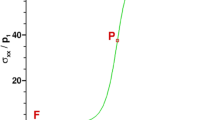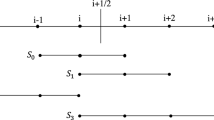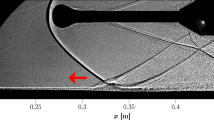Abstract
Shock wave/boundary layer interaction (SWBLI) is studied in a large area-ratio axisymmetric nozzle comprising a design exit Mach number of 5.58. Shock motion unsteadiness is captured by way of the dynamic wall pressure and is evaluated during overexpanded operations up to a nozzle pressure ratio of 65. Stationary SWBLI is first considered at a nozzle pressure ratio of 28.7 such that the internal flow structure is in a restricted shock separated state; the mean position of the annular separation shock resides at a fixed position. Conditional averages of the wall pressure fluctuations show how the motion of the incipient separation shock is out of phase with pressure fluctuations measured in the separated region downstream of the shock; pressure decreases when the shock moves downstream and vice versa. This is indicative of a long intermittent region, in terms of the boundary layer thickness, as the observed phenomena can be explained by translating the static wall pressure profile along with the shock motion. Non-stationary SWBLI is then considered by increasing the nozzle pressure ratio over time (transient start-up). Under these conditions, the shock pattern varies in strength and structure as it sweeps through the nozzle. A time-frequency analyses of the fluctuating wall pressure during the non-stationary operations, and at the same location that the stationary unsteadiness is analyzed, reveals a similar spectral footprint. However, for relatively slower start-ups, the amplitude of the unsteadiness is reduced by a factor of about seven. The findings demonstrate how the rate at which the nozzle pressure ratio increases can have a significant influence on the amplitude of the unsteady shock foot motion.




















Similar content being viewed by others
Notes
Note that the shock zero-crossing frequency is not equal to the mean frequency of shock oscillations.
Overlapping signal partitions of \(N = 2^{14}\) samples are transformed. The regions inside the cone of influence (Farge 1992), for 10 Hz \(< f < f_s/2\), are presented in a continuous fashion throughout the article.
References
Addison PS (2002) The illustrated wavelet transform handbook. Taylor & Francis, New York
Baars WJ, Tinney CE (2013) Transient wall pressures in an overexpanded and large area ratio nozzle. Exp Fluids 54:1468
Baars WJ, Tinney CE, Ruf JH (2011) Time-frequency analysis of rocket nozzle wall pressures during start-up transients. J Phys Conf Ser 318(9):1–10
Baars WJ, Tinney CE, Ruf JH, Brown AM, McDaniels DM (2012) Wall pressure unsteadiness and side loads in overexpanded rocket nozzles. AIAA J 50(1):61–73
Babinsky H, Harvey JK (2011) Shock wave-boundary-layer interactions. Cambridge University Press, New York
Beresh SJ, Clemens NT, Dolling DS (2002) Relationship between upstream turbulent boundary-layer velocity fluctuations and separation shock unsteadiness. AIAA J 40(12):2412–2422
Clemens NT, Narayanaswamy V (2014) Low-frequency unsteadiness of shock wave/turbulent boundary layer interactions. Annu Rev Fluid Mech 46:469–492
Cohen L (1989) Time-frequency distributions—a review. Proc IEEE 77(7):941–981
Das D (1987) A numerical study of turbulent separated flows. ASME FED 51:85–90
Dolling DS (2001) Fifty years of shock-wave/boundary-layer interaction research: What next? AIAA J 39(8):1517–1531
Dolling DS, Brusniak L (1989) Separation shock motion in fin, cylinder, and compression ramp—induced turbulent interactions. AIAA J 27(6):734–742
Dolling DS, Or CT (1985) Unsteadiness of the shock wave structure in attached and separated compression ramp flows. Exp Fluids 3(4):24–32
Donald BW, Baars WJ, Tinney CE, Ruf JH (2014) Sound produced by large area-ratio nozzles during fixed and transient operations. AIAA J 52(7):1474–1485
Dupont P, Haddad C, Debiève JF (2006) Space and time organization in a shock-induced separated boundary layer. J Fluid Mech 559:255–277
Erengil ME, Dolling DS (1991) Unsteady wave structure near separation in a Mach 5 compression ramp interaction. AIAA J 29(5):728–735
Farge M (1992) Wavelet transforms and their application to turbulence. Annu Rev Fluid Mech 24:395–457
Fernholz HH, Warnack D (1998) The effects of a favourable pressure gradient and of the Reynolds number on an incompressible axisymmetric turbulent boundary layer. Part 1. The turbulent boundary layer. J Fluid Mech 359:329–356
Frey M, Hagemann G (2000) Restricted shock separation in rocket nozzles. J Prop Power 16(3):478–484
Gallagher JA, McLaughlin DK (1981) Experiments on the nonlinear characteristics of noise propagation from low and moderate Reynolds number supersonic jets. In: 7th AIAA aeroacoustics conf, Palo Alto, CA, AIAA 1981–2041
Ganapathisubramani B, Clemens NT, Dolling DS (2009) Low-frequency dynamics of shock-induced separation in a compression ramp interaction. J Fluid Mech 636:397–425
Gonsalez JC, Dolling DS (1993) Correlation of interaction sweepback effects on the dynamics of shock-induced turbulent separation. In: 31st AIAA Aerospace Sciences Meeting, Reno, NV, AIAA 1993–0776
Humble RA, Scarano F, van Oudheusden BW (2009) Unsteady aspects of an incident shock wave/turbulent boundary layer interaction. J Fluid Mech 635:47–74
Johnson AD, Papamoschou D (2010) Instability of shock-induced nozzle flow separation. Phys Fluids 22:016102
Luke E (2007) On robust and accurate arbitrary polytope cfd solvers. In: 18th AIAA computational fluid dynamics conf, Miami, FL, AIAA 2007–3956
Luke E, Cinella P (2007) Numerical simulations of mixtures of fluids using upwind algorithms. Comput Fluids 36(10):1547–1566
Menter FR (1992) Influence of freestream values on \(\kappa -\omega \) turbulence model predictions. AIAA J 30(6):1657–1659
Menter FR (1994) Two-equation eddy-viscosity turbulence models for engineering applications. AIAA J 32(8):1598–1605
Nave LH, Coffey GH (1973) Sea level side loads in high-area-ratio rocket engines. In: 9th AIAA Prop. Conf., Las Vegas, NV, AIAA 1973–1284
Nguyen AT, Deniau H, Girard S, Alziary de Roquefort T (2003) Unsteadiness of flow separation and end-effects regime in a thrust-optimized contour rocket nozzle. Flow Turb Comb 71:161–181
Olson BJ, Lele SK (2013) A mechanism for unsteady separation in over-expanded nozzle flow. Phys Fluids 25:110809
Piponniau S, Dussauge JP, Debiève JF, Dupont P (2009) A simple model for low-frequency unsteadiness in shock-induced separation. J Fluid Mech 629:87–108
Plotkin KJ (1975) Shock wave oscillation driven by turbulent boundary-layer fluctuations. AIAA J 13(8):1036–1040
Poggie J, Smits AJ (1997) Wavelet analysis of wall-pressure fluctuations in a supersonic blunt-fin flow. AIAA J 35(10):1597–1603
Priebe S, Martín MP (2012) Low-frequency unsteadiness in shock wave-turbulent boundary layer interaction. J Fluid Mech 699:1–49
Ruf JH, McDaniels DM, Brown AM (2009) Nozzle side load testing and analysis at MSFC. In: 45th AIAA joint prop conf, Denver, CO, AIAA 2009–4856
Ruf JH, McDaniels DM, Brown AM (2010) Cold flow test results for nozzle side loads for J-2X and SSME test articles. In: 57th JANNAF prop meeting, Colorado Springs CO
Sarkar S, Lakshmanan B (1991) Applicaiton of reynolds stress turbulence model to the compressible shear layer. AIAA J 29(5):743–749
Smits AJ, Dussauge JP (2006) Turbulent shear layers in supersonic flow. Springer, New York
Thomas FO, Putman CM, Chu HC (1994) On the mechanism of unsteady shock oscillation in shock wave/turbulent boundary layer interactions. Exp Fluids (18):69–81
Verma SB, Haidn O (2014) Unsteady shock motions in an over-expanded parabolic rocket nozzle. Aerosp Sci Technol 39:48–71
Wang TS (2009) Transient three-dimensional startup side load analysis of a regeneratively cooled nozzle. Shock Waves 19(3):251–264
Wilcox DC (1998) Turbulence modeling for CFD. DCW Industries,
Wu M, Martín MP (2008) Analysis of shock motion in shockwave and turbulent boundary layer interaction using direct numerical simulation data. J Fluid Mech 594:71–83
Zaman KBMQ, Dahl MD, Bencic TJ, Loh CY (2002) Investigation of a ’transonic resonance’ with convergent-divergent nozzles. J Fluid Mech 463:313–343
Acknowledgments
Funding for this effort was graciously provided by a grant from the Air Force Office of Scientific Research (FA9550-11-1-0203) with Dr. J. Schmisseur as technical monitor, as well as the NASA Engineering and Safety Center. A great portion of this work was written while WJB was a Post-Doctoral Research Fellow at the University of Melbourne, Australia and being supported by funds of the Australian Research Council.
Author information
Authors and Affiliations
Corresponding author
Additional information
The experimental campaign was conducted at The University of Texas at Austin during the Spring of 2012.
Rights and permissions
About this article
Cite this article
Baars, W.J., Ruf, J.H. & Tinney, C.E. Non-stationary shock motion unsteadiness in an axisymmetric geometry with pressure gradient. Exp Fluids 56, 92 (2015). https://doi.org/10.1007/s00348-015-1958-y
Received:
Revised:
Accepted:
Published:
DOI: https://doi.org/10.1007/s00348-015-1958-y




